Air Quality Sensors Systems as Tools to Support Guidance in Athletics Stadia for Elite and Recreational Athletes
Abstract
1. Introduction
2. Materials and Methods
2.1. Monitoring Locations, Instrumentation, and Strategy
- The 6 monitors were co-located by the manufacturer over a 15-day period at an EU-reference station from the air quality monitoring network in Navarra (Spain), against which they were calibrated following internal standard procedure. The sensors contain a property algorithm to correct for temperature and humidity influence and gas cross-interference. According to an independent evaluation carried out by the US South Coast AQMD (Air Quality Sensor Performance Evaluation Center, AQ-SPEC, http://www.aqmd.gov/aq-spec# (accessed on 6 February 2022)), the relative intra-model variability (calculated as the absolute intra-model variability relative to the mean of the three sensor means) of Kunak monitors (3 units tested) was 1% for O3, 11% for NO, 3% for NO2, 66% for CO, 13% for PM2.5 and 10% for PM10 (http://www.aqmd.gov/docs/default-source/aq-spec/field-evaluations/kunak-air-a10---field-evaluation.pdf?sfvrsn=24 (accessed on 6 February 2022)). Comparability across the six units used in this study was subsequently assumed, based on this independent evaluation.
- One of the monitors (#1) was deployed at the Barcelona EU-reference air quality monitoring station in Palau Reial, where its performance was compared over a 5-day period to that of EU-reference, research-grade instrumentation. The results are presented in Figure S1 in Supporting Information and Section 3.1. This unit was, at the time, only equipped with sensors for gaseous pollutants. The performance of PMx sensors was validated for another of the units (#5) when it arrived at its destination, where it was possible to co-locate it at a local reference station following non-EU national standard quality procedures, during 3 months (Figure S2 in Supporting Information, and Section 3.1). These intercomparisons were only applied to two of the monitors due to logistical reasons and under the assumption of comparability across units, as described above. It should be noted that the calibration parameters for these nodes were not modified after the comparison so that they remained comparable to the rest of the monitors.
- Finally, the monitors were shipped to their respective stadia and installed by local staff. Once at their destinations, the units were not calibrated against local air pollutant or meteorological reference data, given that access to local reference data was not available at all locations. As discussed above, the purpose of this work was to understand the potential use of sensor data when deployed by users outside the scientific community, and potentially with little to no previous knowledge of the air quality concentrations in the study area, following the “from the shelf to the field” use. Because the monitors were not calibrated locally, the absolute concentrations of particulate and gaseous pollutants monitored should not be used for compliance checking and/or comparisons across cities [38].
2.2. Data Analysis Methods
3. Results and Discussion
3.1. Comparison with Reference Data Prior to Deployment
3.2. Time Series Analysis
3.2.1. Meteorological Variables
3.2.2. Gaseous Pollutants
3.2.3. Particulate Pollutants
3.3. Similarity Analysis Using Self-Organising Maps (SOMs)
4. Conclusions
- (a)
- Guidance for event organisers: hyper-local air quality monitoring in the stadia allows for the identification of periods of the day with the lowest average relative pollutant concentrations. Further research is necessary to identify the exact value range which reference instruments would have reported, as well as the specific air pollutants that may trigger or exacerbate respiratory conditions typical of the athlete community (e.g., asthma or exercise-induced-bronchospasm; [13]).
- (b)
- Guidance for competitions: setting up guidelines and/or air pollutant thresholds would help minimise air pollution exposures for athletes and avoid inequalities in training/competing conditions in different parts of the world, by deciding on the potential cancellation or postponement of events. A similar work was proposed for urban marathons [26].
- (c)
- Guidance for mitigation: certain mitigation actions could be implemented inside the stadia (e.g., application of dust binders). Measures targeting traffic could be implemented by city authorities (e.g., total or partial bans during events), while those targeting regional-scale O3, as identified using the SOMs, would require coordination of city and regional stakeholders.
Supplementary Materials
Author Contributions
Funding
Institutional Review Board Statement
Informed Consent Statement
Data Availability Statement
Acknowledgments
Conflicts of Interest
References
- Brunekreef, B.; Forsberg, B. Epidemiological evidence of effects of coarse airborne particles on health. Eur. Respir. J. 2005, 26, 309–318. [Google Scholar] [CrossRef] [PubMed]
- Burnett, R.; Chen, H.; Szyszkowicz, M.; Fann, N.; Hubbell, B.; Pope, C.A.; Apte, J.S.; Brauer, M.; Cohen, A.; Weichenthal, S.; et al. Global estimates of mortality associated with longterm exposure to outdoor fine particulate matter. Proc. Natl. Acad. Sci. USA 2018, 115, 9592–9597. [Google Scholar] [CrossRef] [PubMed]
- Cohen, A.J.; Brauer, M.; Burnett, R.; Anderson, H.R.; Frostad, J.; Estep, K.; Balakrishnan, K.; Brunekreef, B.; Dandona, L.; Dandona, R.; et al. Estimates and 25-year trends of the global burden of disease attributable to ambient air pollution: An analysis of data from the Global Burden of Diseases Study 2015. Lancet 2017, 389, 1907–1918. [Google Scholar] [CrossRef]
- Héroux, M.-E.; Anderson, H.R.; Atkinson, R.; Brunekreef, B.; Cohen, A.; Forastiere, F.; Hurley, F.; Katsouyanni, K.; Krewski, D.; Krzyzanowski, M.; et al. Quantifying the health impacts of ambient air pollutants: Recommendations of a WHO/Europe project. Int. J. Public Health 2015, 60, 619–627. [Google Scholar] [CrossRef] [PubMed]
- Pope, C.A.; Dockery, D.W. Health Effects of Fine Particulate Air Pollution: Lines that Connect. J. Air Waste Manag. Assoc. 2006, 56, 709–742. [Google Scholar] [CrossRef] [PubMed]
- De Nazelle, A.; Fruin, S.; Westerdahl, D.; Martinez, D.; Ripoll, A.; Kubesch, N.; Nieuwenhuijsen, M. A travel mode comparison of commuters’ exposures to air pollutants in Barcelona. Atmos. Environ. 2012, 59, 151–159. [Google Scholar] [CrossRef]
- Hofman, J.; Samson, R.; Joosen, S.; Blust, R.; Lenaerts, S. Cyclist exposure to black carbon, ultrafine particles and heavy metals: An experimental study along two commuting routes near Antwerp, Belgium. Environ. Res. 2018, 164, 530–538. [Google Scholar] [CrossRef] [PubMed]
- Luengo-Oroz, J.; Reis, S. Assessment of cyclists’ exposure to ultrafine particles along alternative commuting routes in Edinburgh. Atmos. Pollut. Res. 2019, 10, 1148–1158. [Google Scholar] [CrossRef]
- Qiu, Z.; Wang, W.; Zheng, J.; Lv, H. Exposure assessment of cyclists to UFP and PM on urban routes in Xi’an, China. Environ. Pollut. 2019, 250, 241–250. [Google Scholar] [CrossRef] [PubMed]
- Quiros, D.C.; Lee, E.S.; Wang, R.; Zhu, Y. Ultrafine particle exposures while walking, cycling, and driving along an urban residential roadway. Atmos. Environ. 2013, 73, 185–194. [Google Scholar] [CrossRef]
- Rivas, I.; Viana, M.; Moreno, T.; Pandolfi, M.; Amato, F.; Reche, C.; Bouso, L.; Àlvarez-Pedrerol, M.; Alastuey, A.; Sunyer, J.; et al. Child exposure to indoor and outdoor air pollutants in schools in Barcelona, Spain. Environ. Int. 2014, 69, 200–212. [Google Scholar] [CrossRef] [PubMed]
- Amouei Torkmahalleh, M.; Kabay, K.; Bazhanova, M.; Mohiuddin, O.; Obaidullah, M.; Gorjinezhad, S. Investigating the impact of different sport trainings on particulate matter resuspension in a sport center using well-characterized reference instruments and a low-cost monitor. Sci. Total Environ. 2018, 612, 957–965. [Google Scholar] [CrossRef] [PubMed]
- Reche, C.; Viana, M.; van Drooge, B.L.; Fernández, F.J.; Escribano, M.; Castaño-Vinyals, G.; Nieuwenhuijsen, M.; Adami, P.E.; Bermon, S. Athletes’ exposure to air pollution during World Athletics Relays: A pilot study. Sci. Total Environ. 2020, 717, 137161. [Google Scholar] [CrossRef] [PubMed]
- Schiffer, J. The 400 metre. New Stud. Athl. 2008, 23, 7–13. [Google Scholar]
- McCafferty, W.B. Air Pollution and Athletic Performance; Charles C Thomas: Springfield, IL, USA, 1982. [Google Scholar]
- McKenzie, D.C.; Boulet, L.-P. Asthma, outdoor air quality and the Olympic Games. Can. Med. Assoc. J. 2008, 179, 543–548. [Google Scholar] [CrossRef] [PubMed][Green Version]
- Thomas, S.; Wolfarth, B.; Wittmer, C.; Nowak, D.; Radon, K.; GA2LEN-Olympic Study-Team. Self-reported asthma and allergies in top athletes compared to the general population-results of the German part of the GA2LEN-Olympic study 2008. Allergy Asthma Clin. Immunol. 2010, 6, 31. [Google Scholar] [CrossRef] [PubMed]
- Zoladz, J.A.; Nieckarz, Z. Marathon race performance increases the amount of particulate matter deposited in the respiratory system of runners: An incentive for “clean air marathon runs”. PeerJ 2021, 9, e11562. [Google Scholar] [CrossRef]
- Hodgson, J.R.; Chapman, L.; Pope, F.D. The Diamond League athletic series: Does the air quality sparkle? Int. J. Biometeorol. 2021, 65, 1427–1442. [Google Scholar] [CrossRef]
- Adami, P.E.; Fitch, K. The innovative role of Olympic sports and exercise in the promotion of health, gender equality and sustainability. Past achievements and future challenges. J. Sports Med. Phys. Fit. 2021, 61, 1042–1051. [Google Scholar] [CrossRef] [PubMed]
- Fitch, K. Air pollution, athletic health and performance at the Olympic Games. J. Sports Med. Phys. Fit. 2015, 56, 922–932. [Google Scholar]
- Murphy, D.; Wholf, T. Air Quality Issues Expected to Increasingly Impact Sports; ESPN: Bristol, CT, USA, 2020. [Google Scholar]
- Wetsman, N. Wildfire Smoke Forced tennis Players to Withdraw from Australian Open Matches; Theverge: Cincinnati, OH, USA, 2020. [Google Scholar]
- Orr, M. Professional Sports are in the Line of (Wild) Fire; Sportspromedia: London, UK, 2020. [Google Scholar]
- Bunds, K.S.; Casper, J.M.; Frey, H.C.; Barrett, M. Air pollution at college football games: Developing a methodology for measuring air pollutant exposure in a sport event microenvironment. Event Manag. 2019, 23, 399–412. [Google Scholar] [CrossRef]
- Sun, L.; Wong, K.C.; Wei, P.; Ye, S.; Huang, H.; Yang, F.; Westerdahl, D.; Louie, P.K.; Luk, C.W.; Ning, Z. Development and Application of a Next Generation Air Sensor Network for the Hong Kong Marathon 2015. Air Qual. Monit. Sens. 2016, 16, 211. [Google Scholar]
- World Athletics. World Athletics World Athletics Sustainability Strategy 2020–2030; World Athletics: Monaco, 2020. [Google Scholar]
- Palmisani, J.; Di Gilio, A.; Viana, M.; de Gennaro, G.; Ferro, A. Indoor air quality evaluation in oncology units at two European hospitals: Low-cost sensors for TVOCs, PM2.5 and CO2 real-time monitoring. Build. Environ. 2021, 205, 108237. [Google Scholar] [CrossRef]
- Cyrys, J.; Eeftens, M.; Heinrich, J.; Ampe, C.; Armengaud, A.; Beelen, R.; Bellander, T.; Beregszaszi, T.; Birk, M.; Cesaroni, G.; et al. Variation of NO2 and NOx concentrations between and within 36 European study areas: Results from the ESCAPE study. Atmos. Environ. 2012, 62, 374–390. [Google Scholar] [CrossRef]
- Kerckhoffs, J.; Hoek, G.; Gehring, U.; Vermeulen, R. Modelling nationwide spatial variation of ultrafine particles based on mobile monitoring. Environ. Int. 2021, 154, 106569. [Google Scholar] [CrossRef] [PubMed]
- Rivas, I.; Donaire-Gonzalez, D.; Bouso, L.; Esnaola, M.; Pandolfi, M.; de Castro, M.; Viana, M.; Àlvarez-Pedrerol, M.; Nieuwenhuijsen, M.; Alastuey, A.; et al. Spatiotemporally resolved black carbon concentration, schoolchildren’s exposure and dose in Barcelona. Indoor Air 2016, 26, 391–402. [Google Scholar] [CrossRef] [PubMed]
- Castell, N.; Dauge, F.R.; Schneider, P.; Vogt, M.; Lerner, U.; Fishbain, B.; Broday, D.; Bartonova, A. Can commercial low-cost sensor platforms contribute to air quality monitoring and exposure estimates? Environ. Int. 2017, 99, 293–302. [Google Scholar] [CrossRef] [PubMed]
- ETC/ACM. ETC/ACM Report No. 2018/21-Low Cost Sensor Systems for Air Quality Assessment: Possibilities and Challenges; Report No. 2018/21; European Topic Centre on Air Pollution and Climate Change Mitigation: Bilthoven, The Netherlands, 2019. [Google Scholar]
- Gerboles, M.; Spinelle, L.; Borowiak, A. Measuring Air Pollution with Low-Cost Sensors. In Thoughts on the Quality of Data Measured by Sensors; Joint Research Centre, EU Science Hub: Brussels, Belgium, 2017. [Google Scholar]
- Morawska, L.; Thai, P.K.; Liu, X.; Asumadu-Sakyi, A.; Ayoko, G.; Bartonova, A.; Bedini, A.; Chai, F.; Christensen, B.; Dunbabin, M.; et al. Applications of low-cost sensing technologies for air quality monitoring and exposure assessment: How far have they gone? Environ. Int. 2018, 116, 286–299. [Google Scholar] [CrossRef]
- Ripoll, A.; Viana, M.; Padrosa, M.; Querol, X.; Minutolo, A.; Hou, K.M.; Barcelo-Ordinas, J.M.; Garcia-Vidal, J. Testing the performance of sensors for ozone pollution monitoring in a citizen science approach. Sci. Total Environ. 2019, 651, 1166–1179. [Google Scholar] [CrossRef]
- Schneider, P.; Bartonova, A.; Castell, N.; Dauge, F.R.; Gerboles, M.; Hagler, G.S.W.; Hüglin, C.; Jones, R.L.; Khan, S.; Lewis, A.C.; et al. Toward a Unified Terminology of Processing Levels for Low-Cost Air-Quality Sensors. Environ. Sci. Technol. 2019, 53, 8485–8487. [Google Scholar] [CrossRef]
- World Meteorological Organization. WMO Low-Cost Sensors for the Measurement of Atmospheric Composition: Overview of Topic and Future Applications; World Meteorological Organization: Geneva, Switzerland, 2018. [Google Scholar]
- Borrego, C.; Costa, A.M.; Ginja, J.; Amorim, M.; Coutinho, M.; Karatzas, K.; Sioumis, T.; Katsifarakis, N.; Konstantinidis, K.; De Vito, S.; et al. Assessment of air quality microsensors versus reference methods: The EuNetAir joint exercise. Atmos. Environ. 2016, 147, 246–263. [Google Scholar] [CrossRef]
- Viana, M.; Leeuw, F.; de Bartonova, A.; Castell, N.; Ozturk, E.; González Ortiz, A. Air quality mitigation in European cities: Status and challenges ahead. Environ. Int. 2020, 143, 105907. [Google Scholar] [CrossRef] [PubMed]
- Ambient Atmospheres. CEN Air Quality-Performance Evaluation of Air Quality Sensor Systems-Part 1: Gaseous Pollutants in Ambient Air; Ambient Atmospheres: Ljubljana, Slovenia, 2022. [Google Scholar]
- Yatkin, S.; Gerboles, M.; Borowiak, A.; Davila, S.; Spinelle, L.; Bartolova, A.; Dauge, F.; Schneider, P.; Van Poppel, M.; Peters, J.; et al. Modified Target Diagram to check compliance of low-cost sensors with the Data Quality Objectives of the European air quality directive. Atmos. Environ. 2022, 273, 118967. [Google Scholar] [CrossRef]
- Domènech-Gil, G.; Puglisi, D. Benefits of virtual sensors for air quality monitoring in humid conditions. Sens. Actuators B Chem. 2021, 344, 130294. [Google Scholar] [CrossRef]
- Jayaratne, R.; Liu, X.; Thai, P.; Dunbabin, M.; Morawska, L. The influence of humidity on the performance of a low-cost air particle mass sensor and the effect of atmospheric fog. Atmos. Meas. Technol. 2018, 11, 4883–4890. [Google Scholar] [CrossRef]
- Kang, Y.; Aye, L.; Ngo, T.D.; Zhou, J. Performance evaluation of low-cost air quality sensors: A review. Sci. Total Environ. 2021, 818, 151769. [Google Scholar] [CrossRef] [PubMed]
- Kizel, F.; Etzion, Y.; Shafran-Nathan, R.; Levy, I.; Fishbain, B.; Bartonova, A.; Broday, D.M. Node-to-node field calibration of wireless distributed air pollution sensor network. Environ. Pollut. 2018, 233, 900–909. [Google Scholar] [CrossRef] [PubMed]
- Li, Y.; Yuan, Z.; Chen, L.-W.A.; Pillarisetti, A.; Yadav, V.; Wu, M.; Cui, H.; Zhao, C. From air quality sensors to sensor networks: Things we need to learn. Sens. Actuators B Chem. 2022, 351, 130958. [Google Scholar] [CrossRef]
- Gulia, S.; Prasad, P.; Goyal, S.K.; Kumar, R. Sensor-based Wireless Air Quality Monitoring Network (SWAQMN)-A smart tool for urban air quality management. Atmos. Pollut. Res. 2020, 11, 1588–1597. [Google Scholar] [CrossRef]
- Hofman, J.; Do, T.H.; Qin, X.; Bonet, E.R.; Philips, W.; Deligiannis, N.; La Manna, V.P. Spatiotemporal air quality inference of low-cost sensor data: Evidence from multiple sensor testbeds. Environ. Model. Softw. 2022, 149, 105306. [Google Scholar] [CrossRef]
- Kortoçi, P.; Motlagh, N.H.; Zaidan, M.A.; Fung, P.L.; Varjonen, S.; Rebeiro-Hargrave, A.; Niemi, J.V.; Nurmi, P.; Hussein, T.; Petäjä, T.; et al. Air pollution exposure monitoring using portable low-cost air quality sensors. Smart Health 2022, 23, 100241. [Google Scholar] [CrossRef]
- Adamiec, E.; Dajda, J.; Gruszecka-Kosowska, A.; Helios-Rybicka, E.; Kisiel-Dorohinicki, M.; Klimek, R.; Pałka, D.; Was, J. Using medium-cost sensors to estimate air quality in remote locations. Case study of Niedzica, Southern Poland. Atmosphere 2019, 10, 393. [Google Scholar] [CrossRef]
- Williams, R.; Kilaru, V.; Snyder, E.; Kaufman, A.; Dye, T.; Rutter, A.; Russell, A.; Hafner, H. Air Sensor Guidebook; EPA/600/R-14/159 (NTIS PB2015-100610); U.S. Environmental Protection Agency: Washington, DC, USA, 2014.
- Singh, D.; Dahiya, M.; Kumar, R.; Nanda, C. Sensors and systems for air quality assessment monitoring and management: A review. J. Environ. Manag. 2021, 289, 112510. [Google Scholar] [CrossRef] [PubMed]
- Borrego, C.; Ginja, J.; Coutinho, M.; Ribeiro, C.; Karatzas, K.; Sioumis, T.; Katsifarakis, N.; Konstantinidis, K.; Vito, S.; De Esposito, E.; et al. Assessment of air quality microsensors versus reference methods: The EuNetAir Joint Exercise–Part II. Atmos. Environ. 2018, 193, 127–142. [Google Scholar] [CrossRef]
- Kohonen, T. Self-Organized Formation of Topologically Correct Feature Maps. Biol. Cybern. 1982, 43, 59–69. [Google Scholar] [CrossRef]
- Ultsch, A.; Siemon, H.P. Kohonen’s Self Organizing Feature Maps for Exploratory Data Analysis. Proc. Int. Neural Netw. Conf. 1990, 1, 305–308. [Google Scholar]
- Vatanen, T.; Osmala, M.; Raiko, T.; Lagus, K.; Sysi-Aho, M.; Orešič, M.; Honkela, T.; Lähdesmäki, H. Self-organization and missing values in SOM and GTM. Neurocomputing 2015, 147, 60–70. [Google Scholar] [CrossRef]
- Pérez, N.; Pey, J.; Cusack, M.; Reche, C.; Querol, X.; Alastuey, A.; Viana, M. Variability of particle number, black carbon, and PM10, PM2.5, and PM1 Levels and Speciation: Influence of road traffic emissions on urban air quality. Aerosol Sci. Technol. 2010, 44, 487–499. [Google Scholar] [CrossRef]
- Querol, X.; Alastuey, A.; Pandolfi, M.; Reche, C.; Pérez, N.; Minguillón, M.C.; Moreno, T.; Viana, M.; Escudero, M.; Orio, A.; et al. 2001–2012 trends on air quality in Spain. Sci. Total Environ. 2014, 490, 957–969. [Google Scholar] [CrossRef] [PubMed]
- Khatri, S.B.; Holguin, F.C.; Ryan, P.B.; Mannino, D.; Erzurum, S.C.; Teague, W.G. Association of ambient ozone exposure with airway inflammation and allergy in adults with asthma. J. Asthma 2009, 46, 777–785. [Google Scholar] [CrossRef]
- Mortimer, K.M.; Neas, L.M.; Dockery, D.W.; Redline, S.; Tager, I.B. The effect of air pollution on inner-city children with asthma. Eur. Respir. J. 2002, 19, 699–705. [Google Scholar] [CrossRef] [PubMed]
- Thurston, G.D.; Bates, D.V. Air Pollution as an Underappreciated Cause of Asthma Symptoms. JAMA 2003, 290, 1915–1917. [Google Scholar] [CrossRef] [PubMed]
- Shah, A.S.V.; Langrish, J.P.; Nair, H.; McAllister, D.A.; Hunter, A.L.; Donaldson, K.; Newby, D.E.; Mills, N.L. Global association of air pollution and heart failure: A systematic review and meta-analysis. Lancet 2013, 382, 1039–1048. [Google Scholar] [CrossRef]
- Shin, H.H.; Fann, N.; Burnett, R.T.; Cohen, A.; Hubbell, B.J. Outdoor fine particles and nonfatal strokes: Systematic review and meta-analysis. Epidemiology 2014, 25, 835–842. [Google Scholar] [CrossRef] [PubMed]
- Wellenius, G.A.; Burger, M.R.; Coull, B.A.; Schwartz, J.; Suh, H.H.; Koutrakis, P.; Schlaug, G.; Gold, D.R.; Mittleman, M.A. Ambient air pollution and the risk of acute ischemic stroke. Arch. Intern. Med. 2012, 172, 229–234. [Google Scholar] [CrossRef] [PubMed]
- DEC. A Guideline for Managing the Impacts of Dust and Associated Contaminants from Land Development Sites, Contaminated Sites Remediation and Other Related Activities; Department of Environment and Conservation, Government of Western Australia: Joondalup, Australia, 2011.
- Gonzalez, A.; Aitken, D.; Heitzer, C.; Lopez, C.; Gonzalez, M. Reducing mine water use in arid areas through the use of a byproduct road dust suppressant. J. Clean. Prod. 2019, 230, 46–54. [Google Scholar] [CrossRef]
- Gustafsson, M.; Blomqvist, G.; Järlskog, I.; Lundberg, J.; Janhäll, S.; Elmgren, M.; Johansson, C.; Norman, M.; Silvergren, S. Road dust load dynamics and influencing factors for six winter seasons in Stockholm, Sweden. Atmos. Environ. X 2019, 2, 100014. [Google Scholar] [CrossRef]


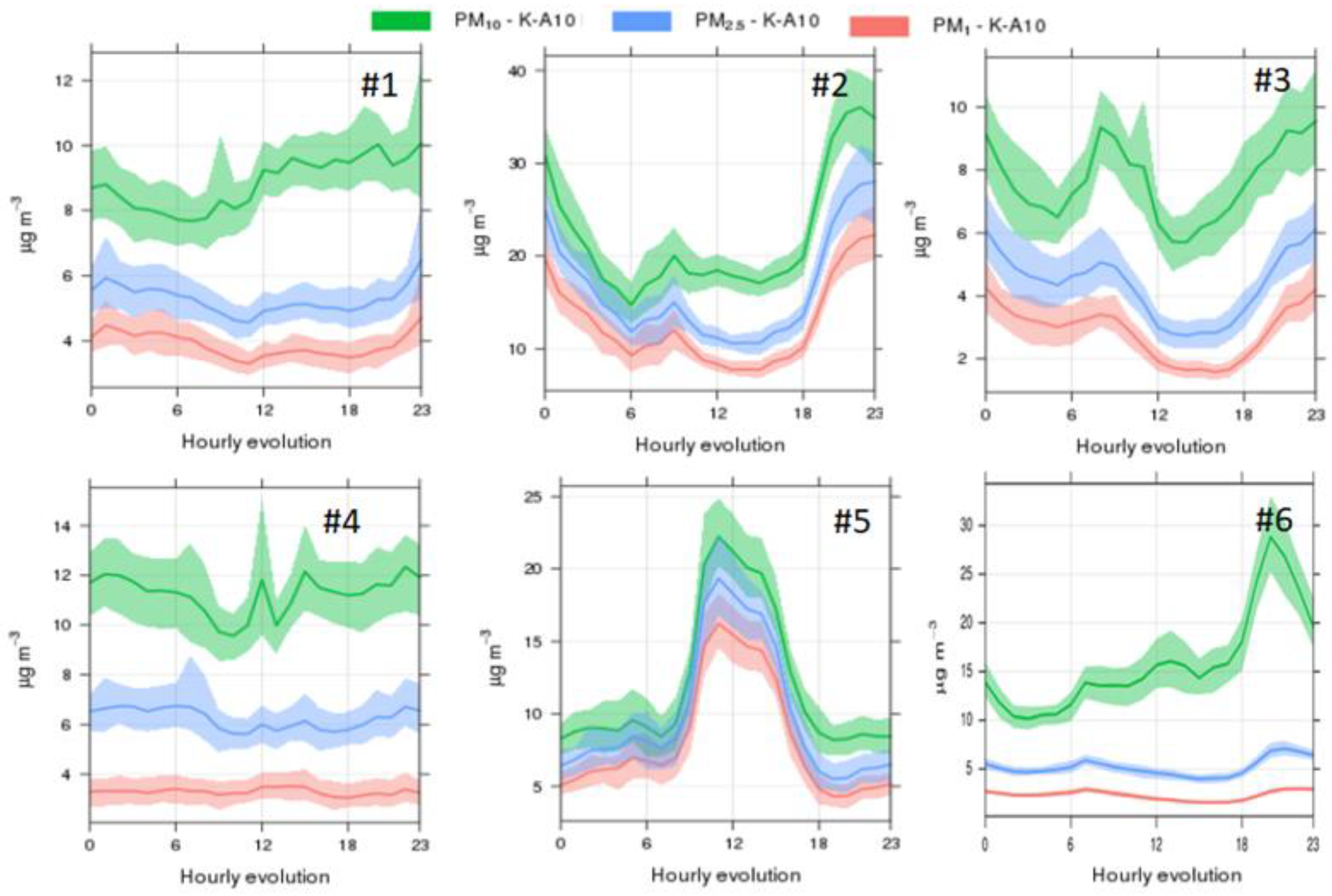
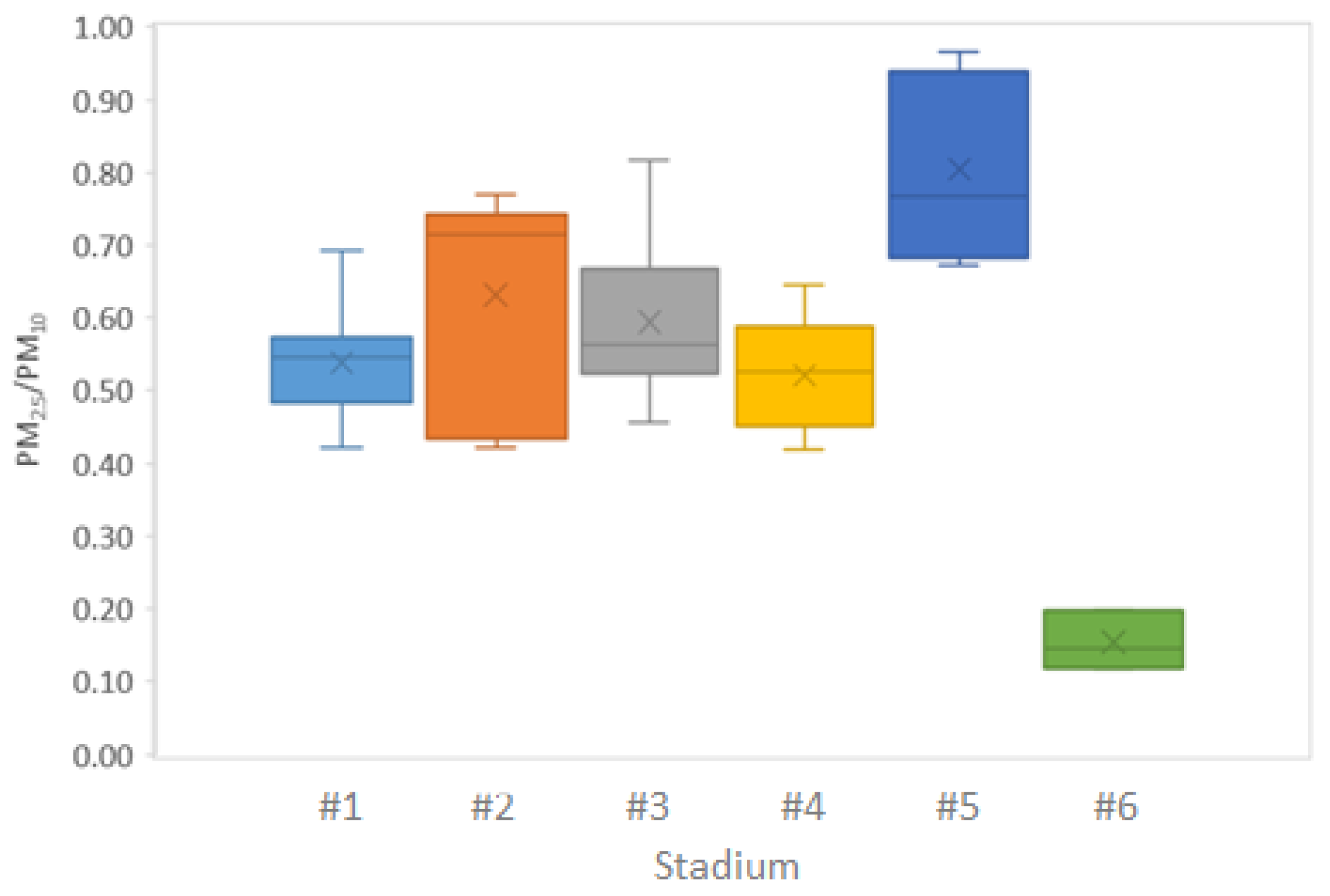


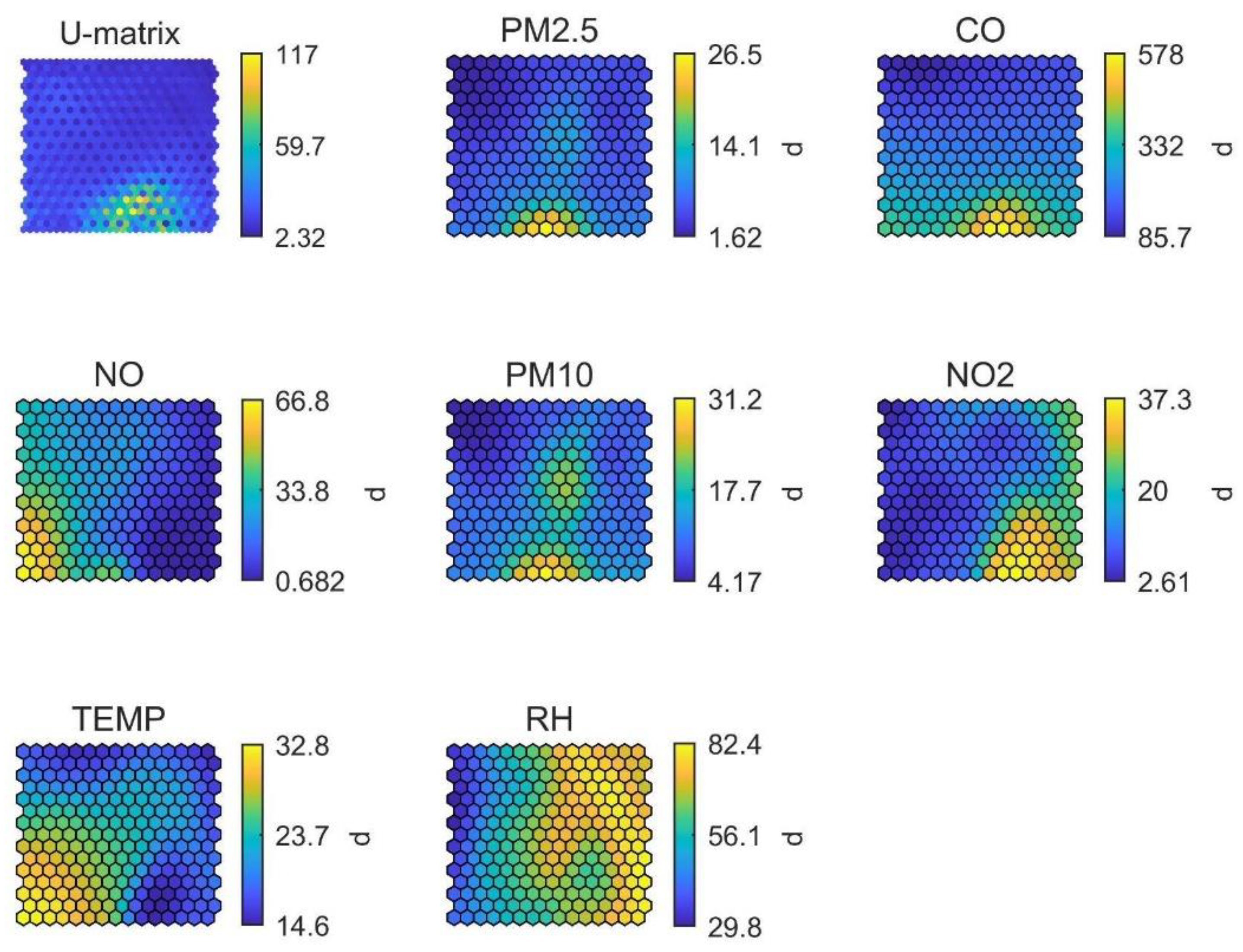
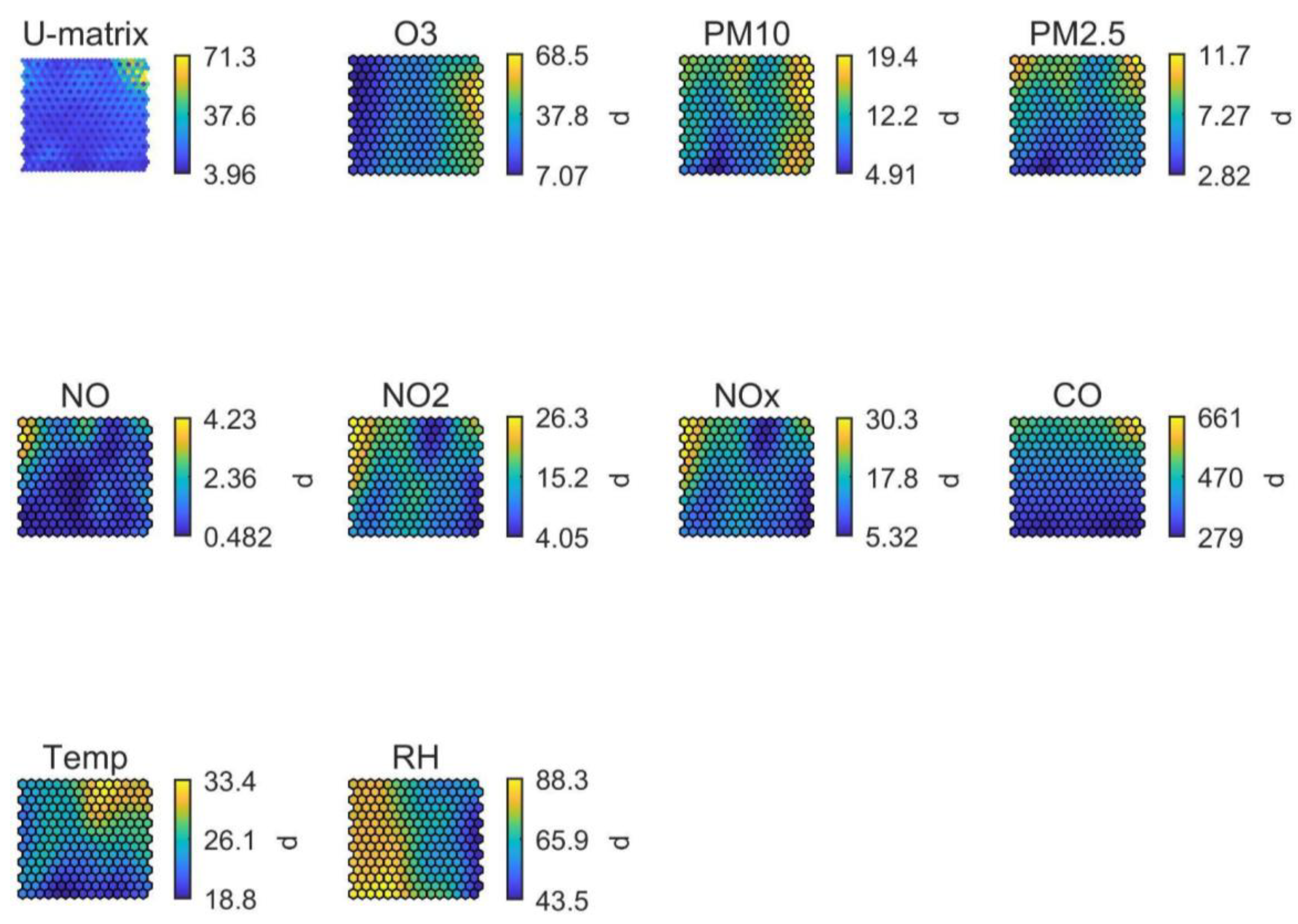
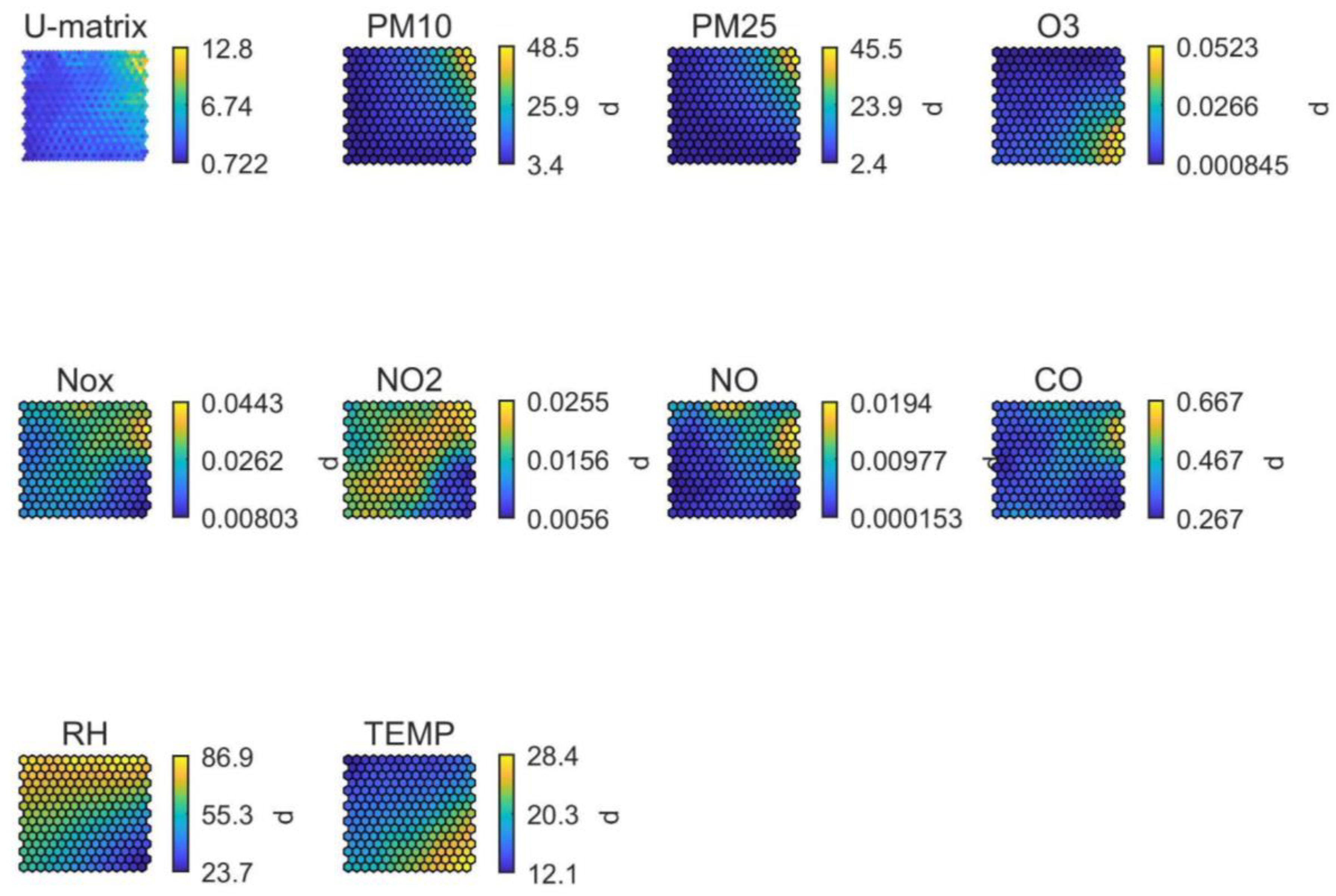
| Location | Stadium#1 | Stadium#2 | Stadium#3 | Stadium#4 | Stadium#5 | Stadium#6 |
|---|---|---|---|---|---|---|
| Continent | Europe | Africa | Oceania | Asia | America | Africa |
| Hemisphere | North | North | South | North | North | South |
| Start | Dec. 2018 | Dec. 2018 | Jan. 2019 | May. 2019 | Feb. 2019 | Aug. 2020 |
| End | Nov. 2019 | Dec. 2019 | Oct. 2019 | Dec. 2019 | Nov. 2019 | Dec. 2020 |
| Nr. Data: NO | 5909 | 3643 | 3580 | 5044 | 7270 | 3606 |
| Nr. Data: NO2 | 5907 | 3628 | 3582 | 5044 | 7270 | 3606 |
| Nr. Data: O3 | 5900 | 3628 | 2707 | 5044 | 7270 | 3606 |
| Nr. Data: PMx | 5910 | 3643 | 3582 | 3472 | 7001 | 1818 |
| Nr. Data: CO | 5910 | 3644 | 3582 | 5044 | 7270 | 3606 |
| Nr. Data: T | 5910 | 3643 | 3582 | 5044 | 7270 | 3606 |
| Nr. Data: RH | 5910 | 3643 | 3582 | 5044 | 7270 | 3606 |
| Local network | Yes | No | Yes | Yes | Yes | No |
Publisher’s Note: MDPI stays neutral with regard to jurisdictional claims in published maps and institutional affiliations. |
© 2022 by the authors. Licensee MDPI, Basel, Switzerland. This article is an open access article distributed under the terms and conditions of the Creative Commons Attribution (CC BY) license (https://creativecommons.org/licenses/by/4.0/).
Share and Cite
Viana, M.; Karatzas, K.; Arvanitis, A.; Reche, C.; Escribano, M.; Ibarrola-Ulzurrun, E.; Adami, P.E.; Garrandes, F.; Bermon, S. Air Quality Sensors Systems as Tools to Support Guidance in Athletics Stadia for Elite and Recreational Athletes. Int. J. Environ. Res. Public Health 2022, 19, 3561. https://doi.org/10.3390/ijerph19063561
Viana M, Karatzas K, Arvanitis A, Reche C, Escribano M, Ibarrola-Ulzurrun E, Adami PE, Garrandes F, Bermon S. Air Quality Sensors Systems as Tools to Support Guidance in Athletics Stadia for Elite and Recreational Athletes. International Journal of Environmental Research and Public Health. 2022; 19(6):3561. https://doi.org/10.3390/ijerph19063561
Chicago/Turabian StyleViana, Mar, Kostas Karatzas, Athanasios Arvanitis, Cristina Reche, Miguel Escribano, Edurne Ibarrola-Ulzurrun, Paolo Emilio Adami, Fréderic Garrandes, and Stéphane Bermon. 2022. "Air Quality Sensors Systems as Tools to Support Guidance in Athletics Stadia for Elite and Recreational Athletes" International Journal of Environmental Research and Public Health 19, no. 6: 3561. https://doi.org/10.3390/ijerph19063561
APA StyleViana, M., Karatzas, K., Arvanitis, A., Reche, C., Escribano, M., Ibarrola-Ulzurrun, E., Adami, P. E., Garrandes, F., & Bermon, S. (2022). Air Quality Sensors Systems as Tools to Support Guidance in Athletics Stadia for Elite and Recreational Athletes. International Journal of Environmental Research and Public Health, 19(6), 3561. https://doi.org/10.3390/ijerph19063561








